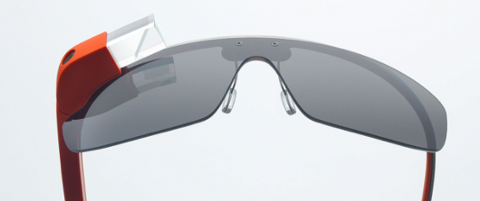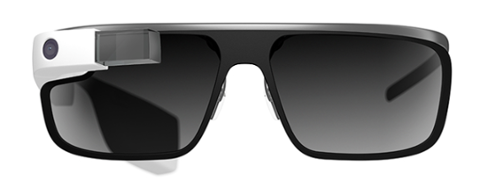 Google Glass will allow users to play songs with a simple voice command.[/caption] Who wants to buy Google Glass? Extreme-sports aficionados and explorers might adopt the augmented-reality headwear as a hands-free way to capture their latest exploits on video. Surgeons could use the hardware’s built-in screen to guide colleagues through an operation thousands of miles away. Technology aficionados will doubtlessly want it as a fashion accessory they can flaunt over friends. But those are relatively narrow segments—and Google doesn’t do anything small. So how will the company angle Glass to appeal to the widest audience possible? That’s the multi-billion-dollar question, but multimedia features could go a long way toward accomplishing such an end: New software gives Google Glass users access to their Google Play music (including Google’s streaming-radio option) via simple voice commands (i.e., “Okay Glass, listen to…”); the company is pairing this latest update with a pair of stereo ear-buds. Promoting Google Glass as a music device could help Google’s broader aims in a number of ways. The Google Play multimedia hub, facing significant competition from Apple’s iTunes (which pioneered many of the central tenets of digital-media consumption) and Amazon (an ambitious competitor with its own big plans for the space), needs something to help it stand out—seamless integration with Google Glass, in addition to a galaxy of Android tablets and smartphones, could go a long way toward helping the platform achieve that sort of prominence. Music could also help make Google Glass “friendlier” to consumers who may find the idea of a voice-activated headset intimidating (or just plain weird), which in turn could help increase initial sales. That’s assuming, of course, that people want wearable electronics in the first place. Earlier this year, BiTE Interactive (in conjunction with YouGov) conducted a survey that found only 10 percent of respondents would wear something like Google Glass regularly; almost half (45 percent) thought the device would be too socially awkward or irritating to wear outside. Another survey, conducted a few months later by Opinion Research Corp. (and paid for by IT-staffing firm Modis) suggested that only 34 percent of respondents who made more than $100,000 a year would consider buying some form of wearable electronic—whether Google Glass, Apple’s much-rumored “iWatch,” or some other device. But even a small fraction of the population wearing Google Glass could translate into hundreds of millions of dollars in annual revenue for Google. That alone might persuade the company to keep pursuing the initiative—and experimenting with features such as music. Image: Google
Google Glass will allow users to play songs with a simple voice command.[/caption] Who wants to buy Google Glass? Extreme-sports aficionados and explorers might adopt the augmented-reality headwear as a hands-free way to capture their latest exploits on video. Surgeons could use the hardware’s built-in screen to guide colleagues through an operation thousands of miles away. Technology aficionados will doubtlessly want it as a fashion accessory they can flaunt over friends. But those are relatively narrow segments—and Google doesn’t do anything small. So how will the company angle Glass to appeal to the widest audience possible? That’s the multi-billion-dollar question, but multimedia features could go a long way toward accomplishing such an end: New software gives Google Glass users access to their Google Play music (including Google’s streaming-radio option) via simple voice commands (i.e., “Okay Glass, listen to…”); the company is pairing this latest update with a pair of stereo ear-buds. Promoting Google Glass as a music device could help Google’s broader aims in a number of ways. The Google Play multimedia hub, facing significant competition from Apple’s iTunes (which pioneered many of the central tenets of digital-media consumption) and Amazon (an ambitious competitor with its own big plans for the space), needs something to help it stand out—seamless integration with Google Glass, in addition to a galaxy of Android tablets and smartphones, could go a long way toward helping the platform achieve that sort of prominence. Music could also help make Google Glass “friendlier” to consumers who may find the idea of a voice-activated headset intimidating (or just plain weird), which in turn could help increase initial sales. That’s assuming, of course, that people want wearable electronics in the first place. Earlier this year, BiTE Interactive (in conjunction with YouGov) conducted a survey that found only 10 percent of respondents would wear something like Google Glass regularly; almost half (45 percent) thought the device would be too socially awkward or irritating to wear outside. Another survey, conducted a few months later by Opinion Research Corp. (and paid for by IT-staffing firm Modis) suggested that only 34 percent of respondents who made more than $100,000 a year would consider buying some form of wearable electronic—whether Google Glass, Apple’s much-rumored “iWatch,” or some other device. But even a small fraction of the population wearing Google Glass could translate into hundreds of millions of dollars in annual revenue for Google. That alone might persuade the company to keep pursuing the initiative—and experimenting with features such as music. Image: Google Google Glass Branching Into Music
[caption id="attachment_14069" align="aligncenter" width="618"]  Google Glass will allow users to play songs with a simple voice command.[/caption] Who wants to buy Google Glass? Extreme-sports aficionados and explorers might adopt the augmented-reality headwear as a hands-free way to capture their latest exploits on video. Surgeons could use the hardware’s built-in screen to guide colleagues through an operation thousands of miles away. Technology aficionados will doubtlessly want it as a fashion accessory they can flaunt over friends. But those are relatively narrow segments—and Google doesn’t do anything small. So how will the company angle Glass to appeal to the widest audience possible? That’s the multi-billion-dollar question, but multimedia features could go a long way toward accomplishing such an end: New software gives Google Glass users access to their Google Play music (including Google’s streaming-radio option) via simple voice commands (i.e., “Okay Glass, listen to…”); the company is pairing this latest update with a pair of stereo ear-buds. Promoting Google Glass as a music device could help Google’s broader aims in a number of ways. The Google Play multimedia hub, facing significant competition from Apple’s iTunes (which pioneered many of the central tenets of digital-media consumption) and Amazon (an ambitious competitor with its own big plans for the space), needs something to help it stand out—seamless integration with Google Glass, in addition to a galaxy of Android tablets and smartphones, could go a long way toward helping the platform achieve that sort of prominence. Music could also help make Google Glass “friendlier” to consumers who may find the idea of a voice-activated headset intimidating (or just plain weird), which in turn could help increase initial sales. That’s assuming, of course, that people want wearable electronics in the first place. Earlier this year, BiTE Interactive (in conjunction with YouGov) conducted a survey that found only 10 percent of respondents would wear something like Google Glass regularly; almost half (45 percent) thought the device would be too socially awkward or irritating to wear outside. Another survey, conducted a few months later by Opinion Research Corp. (and paid for by IT-staffing firm Modis) suggested that only 34 percent of respondents who made more than $100,000 a year would consider buying some form of wearable electronic—whether Google Glass, Apple’s much-rumored “iWatch,” or some other device. But even a small fraction of the population wearing Google Glass could translate into hundreds of millions of dollars in annual revenue for Google. That alone might persuade the company to keep pursuing the initiative—and experimenting with features such as music. Image: Google
Google Glass will allow users to play songs with a simple voice command.[/caption] Who wants to buy Google Glass? Extreme-sports aficionados and explorers might adopt the augmented-reality headwear as a hands-free way to capture their latest exploits on video. Surgeons could use the hardware’s built-in screen to guide colleagues through an operation thousands of miles away. Technology aficionados will doubtlessly want it as a fashion accessory they can flaunt over friends. But those are relatively narrow segments—and Google doesn’t do anything small. So how will the company angle Glass to appeal to the widest audience possible? That’s the multi-billion-dollar question, but multimedia features could go a long way toward accomplishing such an end: New software gives Google Glass users access to their Google Play music (including Google’s streaming-radio option) via simple voice commands (i.e., “Okay Glass, listen to…”); the company is pairing this latest update with a pair of stereo ear-buds. Promoting Google Glass as a music device could help Google’s broader aims in a number of ways. The Google Play multimedia hub, facing significant competition from Apple’s iTunes (which pioneered many of the central tenets of digital-media consumption) and Amazon (an ambitious competitor with its own big plans for the space), needs something to help it stand out—seamless integration with Google Glass, in addition to a galaxy of Android tablets and smartphones, could go a long way toward helping the platform achieve that sort of prominence. Music could also help make Google Glass “friendlier” to consumers who may find the idea of a voice-activated headset intimidating (or just plain weird), which in turn could help increase initial sales. That’s assuming, of course, that people want wearable electronics in the first place. Earlier this year, BiTE Interactive (in conjunction with YouGov) conducted a survey that found only 10 percent of respondents would wear something like Google Glass regularly; almost half (45 percent) thought the device would be too socially awkward or irritating to wear outside. Another survey, conducted a few months later by Opinion Research Corp. (and paid for by IT-staffing firm Modis) suggested that only 34 percent of respondents who made more than $100,000 a year would consider buying some form of wearable electronic—whether Google Glass, Apple’s much-rumored “iWatch,” or some other device. But even a small fraction of the population wearing Google Glass could translate into hundreds of millions of dollars in annual revenue for Google. That alone might persuade the company to keep pursuing the initiative—and experimenting with features such as music. Image: Google
 Google Glass will allow users to play songs with a simple voice command.[/caption] Who wants to buy Google Glass? Extreme-sports aficionados and explorers might adopt the augmented-reality headwear as a hands-free way to capture their latest exploits on video. Surgeons could use the hardware’s built-in screen to guide colleagues through an operation thousands of miles away. Technology aficionados will doubtlessly want it as a fashion accessory they can flaunt over friends. But those are relatively narrow segments—and Google doesn’t do anything small. So how will the company angle Glass to appeal to the widest audience possible? That’s the multi-billion-dollar question, but multimedia features could go a long way toward accomplishing such an end: New software gives Google Glass users access to their Google Play music (including Google’s streaming-radio option) via simple voice commands (i.e., “Okay Glass, listen to…”); the company is pairing this latest update with a pair of stereo ear-buds. Promoting Google Glass as a music device could help Google’s broader aims in a number of ways. The Google Play multimedia hub, facing significant competition from Apple’s iTunes (which pioneered many of the central tenets of digital-media consumption) and Amazon (an ambitious competitor with its own big plans for the space), needs something to help it stand out—seamless integration with Google Glass, in addition to a galaxy of Android tablets and smartphones, could go a long way toward helping the platform achieve that sort of prominence. Music could also help make Google Glass “friendlier” to consumers who may find the idea of a voice-activated headset intimidating (or just plain weird), which in turn could help increase initial sales. That’s assuming, of course, that people want wearable electronics in the first place. Earlier this year, BiTE Interactive (in conjunction with YouGov) conducted a survey that found only 10 percent of respondents would wear something like Google Glass regularly; almost half (45 percent) thought the device would be too socially awkward or irritating to wear outside. Another survey, conducted a few months later by Opinion Research Corp. (and paid for by IT-staffing firm Modis) suggested that only 34 percent of respondents who made more than $100,000 a year would consider buying some form of wearable electronic—whether Google Glass, Apple’s much-rumored “iWatch,” or some other device. But even a small fraction of the population wearing Google Glass could translate into hundreds of millions of dollars in annual revenue for Google. That alone might persuade the company to keep pursuing the initiative—and experimenting with features such as music. Image: Google
Google Glass will allow users to play songs with a simple voice command.[/caption] Who wants to buy Google Glass? Extreme-sports aficionados and explorers might adopt the augmented-reality headwear as a hands-free way to capture their latest exploits on video. Surgeons could use the hardware’s built-in screen to guide colleagues through an operation thousands of miles away. Technology aficionados will doubtlessly want it as a fashion accessory they can flaunt over friends. But those are relatively narrow segments—and Google doesn’t do anything small. So how will the company angle Glass to appeal to the widest audience possible? That’s the multi-billion-dollar question, but multimedia features could go a long way toward accomplishing such an end: New software gives Google Glass users access to their Google Play music (including Google’s streaming-radio option) via simple voice commands (i.e., “Okay Glass, listen to…”); the company is pairing this latest update with a pair of stereo ear-buds. Promoting Google Glass as a music device could help Google’s broader aims in a number of ways. The Google Play multimedia hub, facing significant competition from Apple’s iTunes (which pioneered many of the central tenets of digital-media consumption) and Amazon (an ambitious competitor with its own big plans for the space), needs something to help it stand out—seamless integration with Google Glass, in addition to a galaxy of Android tablets and smartphones, could go a long way toward helping the platform achieve that sort of prominence. Music could also help make Google Glass “friendlier” to consumers who may find the idea of a voice-activated headset intimidating (or just plain weird), which in turn could help increase initial sales. That’s assuming, of course, that people want wearable electronics in the first place. Earlier this year, BiTE Interactive (in conjunction with YouGov) conducted a survey that found only 10 percent of respondents would wear something like Google Glass regularly; almost half (45 percent) thought the device would be too socially awkward or irritating to wear outside. Another survey, conducted a few months later by Opinion Research Corp. (and paid for by IT-staffing firm Modis) suggested that only 34 percent of respondents who made more than $100,000 a year would consider buying some form of wearable electronic—whether Google Glass, Apple’s much-rumored “iWatch,” or some other device. But even a small fraction of the population wearing Google Glass could translate into hundreds of millions of dollars in annual revenue for Google. That alone might persuade the company to keep pursuing the initiative—and experimenting with features such as music. Image: Google 

